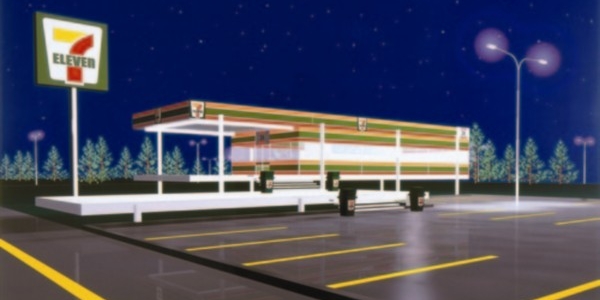When you pull into Heide Museum of Modern Art’s main car park, don’t be alarmed by the Le Pine Funerals sign that greets you. The map has not led you astray. And no, the gallery has not traded in culture for cadavers.
The sign is part of Callum Morton’s mid-career survey, In Memoriam, which will be showcased at Heide III until October 16. This mischievously placed sculpture hints at the themes which recur throughout the exhibition and, indeed, throughout Morton’s oeuvre. The show’s title refers to his reluctance to do a retrospective and his self-confessed “neuroses about trawling through your past”. Unsurprisingly, this is Morton’s first show of this type. “There was that sense of the retrospective as a kind of death, the museum as mausoleum or tomb, so I was kind of playing on that idea,” he says. “But then really it seemed appropriate because of the lives and the history of Heide… It’s a kind of ghost world out there”.
Born in Canada, Morton trained as an architect before later deciding to study painting and then sculpture at RMIT. But in a career spanning now over twenty years, Morton has repeatedly returned to architectural forms in his artistic practice. His work has been exhibited extensively both at home and internationally, his tomb-like sculpture Valhalla representing Australia in the 2007 Venice Biennale. “I was interested not so much in architecture and buildings, even though I do like them, but in the ideas around them. So the models became containers for soundtracks and for framed narratives,” explains Morton. “It was always the subject of architecture, or the model as a thing to use, a container of wonder”.
In Memoriam includes a selection of works from Morton’s archive, as well as several new pieces created specifically for the exhibition, many of which take inspiration from Heide II – the iconic modernist house that the Reeds commissioned from McGlashan and Everist in the 1960s. For Morton, this building, which was designed to appear like a ruin in the landscape, encapsulates many of his ideas about the intersection of architecture and history. “The more I researched it, the more I realised that that was this kind of perfect subject,” says Morton. “It is perfect in a sense that if some of my work looks at the public history of these spaces coupled with the private history, Heide… is always negotiating its past and always has to”.
New works include One to One (2011), an exact replica of the fireplace in Heide II from whose depths the voices of John and Sunday Reed echo. Where this work is somewhat sentimental, digital print Ghost Train (2011) is more playful about Heide’s history – the serious exterior of Heide II is transformed into carnival ride, replete with licking flames, devilish skulls and a garish paint job.
The curation of the show also takes inspiration from the site. Morton has recreated the interior and exterior walls of Heide II on the ramp of the gallery, Monument #27: Screen Walls (2011), transforming this often-unusable space and guiding our path through his work toward Monument #28: Vortex (2011), which forms the focal point of the exhibition. This glass shopfront houses a rocky, womb-like tunnel to Heide’s gardens, a portal of escape from which we are denied entrance.
Older works notably include International Style (1999), Morton’s scale model of Miles van der Rohe’s infamous Farnsworth House; and Gas and Fuel (2002), a 1:34 model of the building that originally stood on the Federation Square site. Beneath Gas and Fuel‘s austere surfaces someone screams, ‘Help me! Please, help me!’, a loop of the final pleas of the fly from the eponymous 1958 movie. Housed in the first room of the gallery, this comic yet utterly creepy voice echoes like another ghost throughout the exhibition.
Like all Morton’s models, there is something tantalizing and ultimately frustrating about these works. We will never get inside his miniature worlds, no matter how much we ache to. Also showcased are Morton’s screens series, some previously unseen photographs, several of his awnings and a collection of drawings from 1989 to today.
When asked if there’s anything he wants people to take away from his work, Morton simply replies, “I hope they enjoy it”. But on the journey home from Heide, there may be something imperceptibly different about each suburban facade, decrepit shop front or towering office block that you pass. Who knows the histories that teem beneath their seemingly everyday exteriors?

